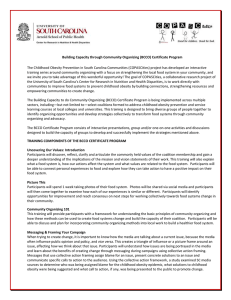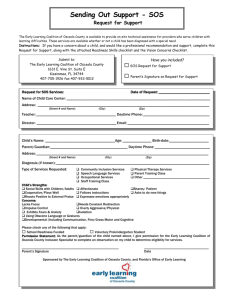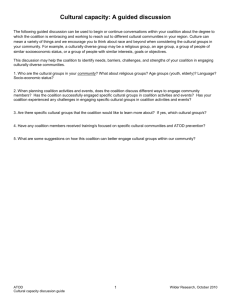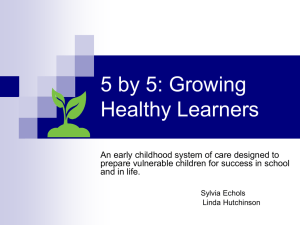Implementing Childhood Obesity Prevention Research in a Rural
advertisement
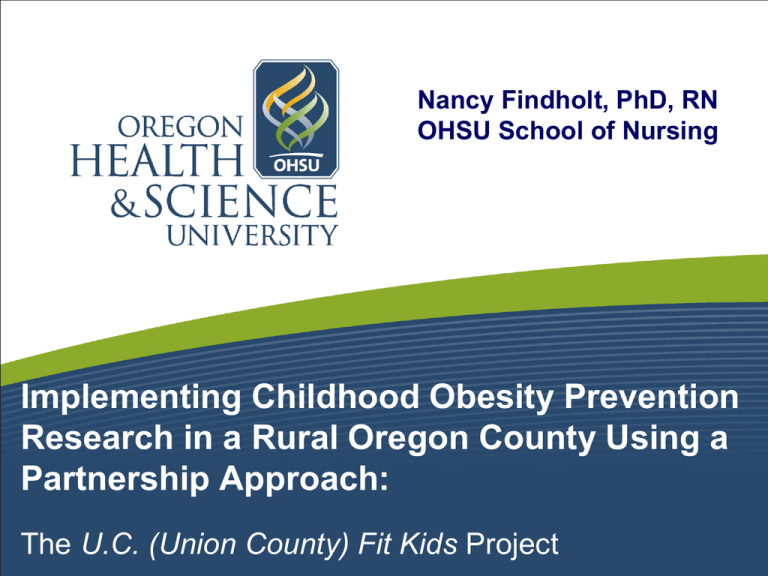
Nancy Findholt, PhD, RN OHSU School of Nursing Implementing Childhood Obesity Prevention Research in a Rural Oregon County Using a Partnership Approach: The U.C. (Union County) Fit Kids Project Overview • Introduction – Community-based participatory research – Childhood obesity in rural areas • Steps taken to implement the project • Strategies for building an effective community-university partnership What is Community-Based Participatory Research? • “a collaborative approach to research that equitably involves all partners in the research process and recognizes the unique strengths that each brings. CBPR begins with a research topic of importance to the community and has the aim of combining knowledge with action and achieving social change.” * * W.K Kellogg Foundation Key Principles of CBPR • Builds on community strengths • It is collaborative • It integrates knowledge with action • The goal is to achieve social change in order to improve health & well-being Childhood Obesity in Rural America • Rural children are 25% more likely to be overweight or obese than their urban counterparts* • The underlying cause of this disparity is believed to be environmental • Our focus: to understand & address the environmental contributors to childhood obesity in our rural area * Lutfiyya et al., 2007 Impetus for the Project • U.C. Fit Kids evolved out of a previous collaborative effort to develop a school health program • Prompted by the growing evidence of childhood obesity • Congress had just passed legislation mandating that schools develop wellness policies Step 1: Assessing Readiness • Key informant interviews were conducted using questions from the Community Readiness Model* • Results: – Union County was at a low level of readiness, but school personnel were more aware & concerned – Several participants offered to participate *Plested et al., 2004 Step 2: Structuring Community Involvement • Coalition partners – – – – – School districts Hospital Extension Service Head Start EOU & OHSU - Comm. on Children & Families - Public health - Parks & Recreation - Other groups & individuals • Coalition launched at a full-day retreat – Established the infrastructure – Introduced participants to the idea of environmental influences Step 3: Getting Started • With the help of college students: – Conducted a countywide BMI screening – Collected baseline data on children’s physical activities & diets – Held a contest to design a logo • Helped the schools to develop wellness policies • Provided a nutrition class to school food service personnel Step 4: Assessing Influences on Physical Activity & Diets • Received 2 grants for assessment • Collected data from community leaders, school administrators & food service personnel, teachers, parents, adolescents, and children • The data revealed many barriers to physical activity & healthy eating, but also a few facilitators Assessment Findings • Barriers to physical activity – Limited recreational resources – Unsafe streets – Fear of strangers – Limited physical education • Facilitators of physical activity – Popularity of youth sports – Proximity to the natural environment Assessment Findings continued • Barriers to healthy eating – Limited availability of healthy food in small communities – Convenience stores near schools – High fat entrees in school meals – School practices that encouraged unhealthy eating • Facilitators of healthy eating – Popularity of gardening Step 5: Developing an Action Plan • Findings reviewed & discussion within coalition • Public input was obtained • This feedback was used to set priorities for intervention – Improve quality of school meals – Increase availability of healthy food in small communities – Provide more physical activity at school – Increase opportunities for life-long activities Step 5 continued • Coalition brainstormed about potential strategies to address the priorities • Action plan created from ideas that were generated Current Status • We are in early stages of implementation • Coalition partners have taken the lead to find funding & initiate projects – Farm-to-school – Walking school bus – Brought a large educational event to Union County • Over $450,000 in grant funding has been brought to the County Lessons Learned • Building on an existing, positive relationship allowed us to start quickly • School participation & endorsement helped us to advance our agenda • The coalition chairwoman’s connections within the county helped to launch the project Lessons Learned continued • The passage of legislation on school wellness policies helped to secure the schools’ commitment • Providing honorariums & stipends to coalition partners helped to sustain their involvement Acknowledgements • Thank you to: – The members of the U.C. Fit Kids coalition – My research partners • Vicky Brogoitti, Union Co Comm on Children & Families • Dr Yvonne Michael, Drexel University • Dr Linda Jerofke, Eastern Oregon University – Our primary funding partners • National Institute of Nursing Research • Northwest Health Foundation


